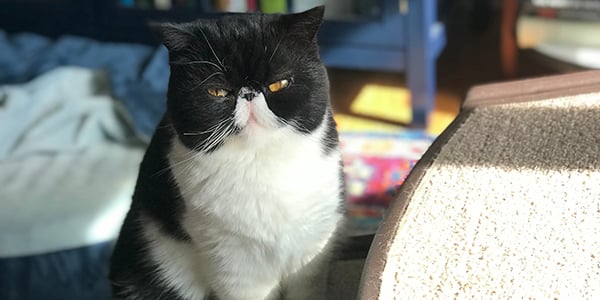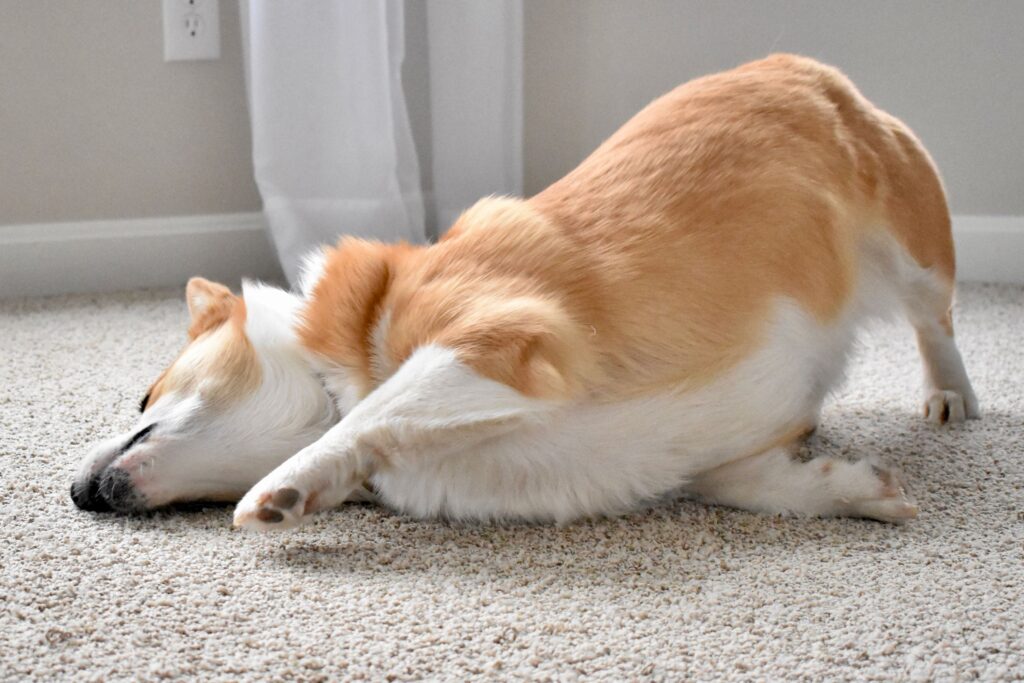Bunny kicking is a natural behavior for cats, used for play and hunting. Encourage interactive play and provide toys to redirect their energy.
Cats are fascinating creatures that exhibit a range of peculiar behaviors, one of which is bunny kicking. If you’ve ever witnessed your furry friend vigorously kicking with their hind legs, you might wonder what’s going on. This behavior is perfectly normal and stems from their primal instincts of play and hunting.
Understanding why your cat engages in bunny kicking and what you can do to encourage healthy play is essential for their well-being. We will delve deeper into the reasons behind this behavior and offer practical tips on how to engage your feline friend in interactive play to fulfill their natural instincts. So, let’s get started and unravel the mystery of bunny kicking in cats.
Contents
- 1 Understanding The Bunny Kicking Phenomenon
- 2 Triggers For Bunny Kicking In Cats
- 3 Observing Bunny Kicking In Action
- 4 Addressing Bunny Kicking: Do’s And Don’ts
- 5 Seek Professional Help If Needed
- 6 Conclusion: Embracing Your Cat’s Quirks
- 7 Frequently Asked Questions Of Why Does My Cat Bunny Kick And What Should I Do
- 8 Conclusion
Understanding The Bunny Kicking Phenomenon
Bunny kicking is a behavior commonly exhibited by cats, where they use their hind legs to kick and claw at objects. It is a natural instinct that is seen in both domesticated and wild cats. There are a few possible reasons behind this behavior:
- The natural instincts at play: Bunny kicking is a way for cats to practice hunting techniques and release energy. It mimics the actions of catching and killing prey, allowing cats to exercise their predatory instincts.
- The need for stimulation: Cats may bunny kick to alleviate boredom or frustration. Providing interactive toys and engaging playtime can help redirect this behavior.
- Self-defense: Bunny kicking can also be a defensive behavior. Cats may use this technique when they feel threatened or need to protect themselves.
In conclusion, bunny kicking is a natural behavior for cats that serves various purposes. Understanding why your cat engages in this behavior can help you provide them with appropriate outlets for their instincts and needs.

Credit: www.preventivevet.com
Triggers For Bunny Kicking In Cats
Cats often engage in bunny kicking, a natural behavior that involves using their hind legs to kick or scratch. This behavior can have various triggers and understanding them can help you address the issue appropriately.
One common trigger for bunny kicking is during playtime. Cats have a strong instinct to hunt, and bunny kicking is a way for them to simulate hunting prey. It’s a form of predatory play and allows them to release pent-up energy. Providing interactive toys and play sessions can help satisfy this instinctual behavior.
Another trigger for bunny kicking is during handling or petting sessions. Cats may use their hind legs to kick as a way to release excess energy or excitement. Understanding your cat’s body language and respecting their boundaries can help prevent unwanted bunny kicks during these interactions.
Cats may also bunny kick when they are stressed or fearful. This behavior serves as a defense mechanism, allowing them to protect themselves. Identifying and addressing the underlying cause of their stress or fear can help alleviate this behavior.
Observing Bunny Kicking In Action
Observing bunny kicking behavior in cats can be fascinating. This adorable, playful action involves a cat using its hind legs to rapidly kick in the air. Identifying this behavior is crucial to understanding your cat’s needs and preferences.
Recognizing associated body language can help determine the reason behind bunny kicking. Twitching tail, dilated pupils, and an arched back may suggest excitement or playfulness. However, aggressive bunny kicking can be accompanied by flattened ears, hissing, or growling, indicating hostility.
Differentiating between playful and aggressive kicking is essential. Playful bunny kicking is usually accompanied by a playful posture, with the front paws extended and an engaging expression. In contrast, aggressive kicking involves intense eye contact, crouching, and a stiff body posture.
Understanding why your cat bunny kicks can help you tailor their environment and playtime accordingly. Providing appropriate toys, engaging in interactive play, and seeking advice from a veterinary professional can ensure your cat’s physical and mental well-being.
Addressing Bunny Kicking: Do’s And Don’ts
Bunny kicking is a common behavior in cats, which involves rapid kicking movements using their hind legs. It can be seen during play or even when interacting with their owners. To address this behavior, it is important to understand the underlying reasons and take appropriate action. Providing appropriate outlets for energy: Cats need physical and mental stimulation to expend their energy. Providing them with toys like laser pointers, feather wands, or interactive treat puzzles can help redirect their bunny kicking behavior. Engaging in interactive play sessions: Regular play sessions not only help bond with your cat but also provide an outlet for their natural hunting instincts. Use toys that mimic prey-like movements to encourage them to chase and pounce rather than bunny kick. Avoiding rough or forceful handling: Cats may bunny kick if they are feeling threatened or uncomfortable. It is important to handle them gently and avoid any rough or forceful actions that may trigger this behavior. Creating a stimulating environment: Enrich your cat’s environment with scratching posts, climbing trees, and hiding spots to keep them mentally stimulated. This can help reduce the need for bunny kicking as a means of entertainment. By understanding the reasons behind bunny kicking and implementing these strategies, you can redirect your cat’s behavior and create a harmonious living environment.
Seek Professional Help If Needed
Seeking professional help from a veterinarian or animal behaviorist is crucial if your cat’s bunny kicking behavior becomes excessive or aggressive. A veterinarian can help determine if there are any underlying health issues causing this behavior. They will conduct a thorough examination to rule out any medical conditions. Identifying and addressing any underlying physical discomfort or pain is essential for managing your cat’s kicking behavior.
If no health issues are found, consulting an animal behaviorist can be beneficial. They specialize in understanding animal behavior patterns and can provide guidance on implementing effective behavior modification techniques. These professionals can assess your cat’s specific situation and offer tailored strategies to mitigate the bunny kicking behavior.
Conclusion: Embracing Your Cat’s Quirks
Cats engage in bunny kicking behavior for various reasons, such as playfulness, hunting instincts, or even a way to defend themselves. This is a natural behavior for cats and should be accepted and appreciated by cat owners. Bunny kicking, where the cat grips an object or their owner with their front paws and uses their back legs to kick, is a normal part of their play behavior.
Understanding this behavior is key to building a strong bond with your feline companion. Instead of discouraging bunny kicking, it is important to redirect their attention to appropriate toys or scratching posts. By providing interactive toys and engaging in playtime, you can help fulfill your cat’s hunting instincts in a positive way.
Positive reinforcement is also essential when it comes to managing and encouraging desired behavior. Rewarding your cat with treats or praise when they engage in appropriate play behavior can reinforce good habits. However, it is important to remember that each cat is unique, and their preferences and behaviors may vary.
| Accepting and appreciating your cat’s bunny kicking behavior: |
|---|
| – Bunny kicking is a natural behavior |
| – Redirect their attention to appropriate toys |
| – Provide interactive toys and engage in playtime |
| – Use positive reinforcement to encourage desired behavior |
| – Remember that each cat is unique |
By embracing your cat’s quirks, including their bunny kicking behavior, you can strengthen your bond and create a harmonious relationship with your feline friend.
Frequently Asked Questions Of Why Does My Cat Bunny Kick And What Should I Do
How Do I Stop My Cat From Bunny Kicking?
To stop your cat from bunny kicking, redirect their energy by providing interactive toys and play sessions. It’s also helpful to keep their nails trimmed and provide scratching posts. Giving them enough mental and physical stimulation can reduce this behavior.
Why Does My Cat Bunny Kick My Kitten?
Cats bunny kick kittens to establish dominance and show their superiority.
Why Is My Cat Bunny Kicking Me?
Cats bunny kick to show affection, playfulness, or excitement. It’s a natural behavior that mimics hunting instincts.
Why Does My Cat Bunny Kick?
Bunny kicking is a natural instinct in cats, often used during play or hunting. It’s a way for them to release energy and engage in interactive behavior. It’s perfectly normal for your cat to bunny kick, but if it becomes aggressive or dangerous, seek advice from a veterinarian or cat behaviorist.
Conclusion
To conclude, understanding why your cat bunny kicks is essential for a harmonious relationship. By recognizing this instinctive behavior, you can provide appropriate outlets and toys to satisfy their need for physical and mental stimulation. Remember, positive reinforcement is key when redirecting their behavior.
So, engage in play sessions, offer scratching posts, and create a stimulating environment to ensure a happy and healthy feline companion. Don’t forget to consult a veterinarian if you notice any concerning or escalating behaviors. Your furry friend will thank you!

Katie Lindsey is a passionate cat lover and founder of Cats Solution, a comprehensive resource for all things feline. With a lifelong love for cats and extensive knowledge in their care and behavior, she provides expert advice and solutions to cat owners. Through her website, Katie fosters a supportive community where cat enthusiasts can find guidance and heartwarming stories. A dedicated advocate for animal welfare, Katie also promotes responsible pet ownership and adoption. Join her on this purr-fect journey celebrating the joy of feline companionship.



